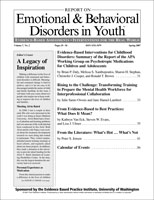From Evidence-Based to Best Practices: What Does It Mean
Author: Kathryn Van Eck, B.M..; Steven Evans, Ph.D..; Lisa Ulmer.
Source: Volume 07, Number 02, Spring 2007 , pp.35-40(6)

< previous article |next article > |return to table of contents
Abstract:
The burgeoning use of the term “evidence-based” has appeared in international as well as domestic contexts. National policy groups and legislative committees have gravitated toward evidence-based treatments (EBTs), and governments in Canada, Germany, and the United Kingdom have commissioned reports that examine the empirical support for psychological interventions. The narrow budgetary parameters typical for government-funded programs have attracted legislators to mental health options that are most likely to produce successful outcomes. Unfortunately, the continued confusion about the definition of evidence-based treatments leads some to wonder if the term still has meaningful value. This article addresses that confusion in the context of a best practices model that shifts attention away from the false dichotomy of science and practice to an emphasis on expertise and data gathered from both.Keywords:
Affiliations:
1: Psychological Sciences Master’s Program, James Madison University; 2: Alvin V. Baird Attention & Learning Disabilities Center, James Madison University.